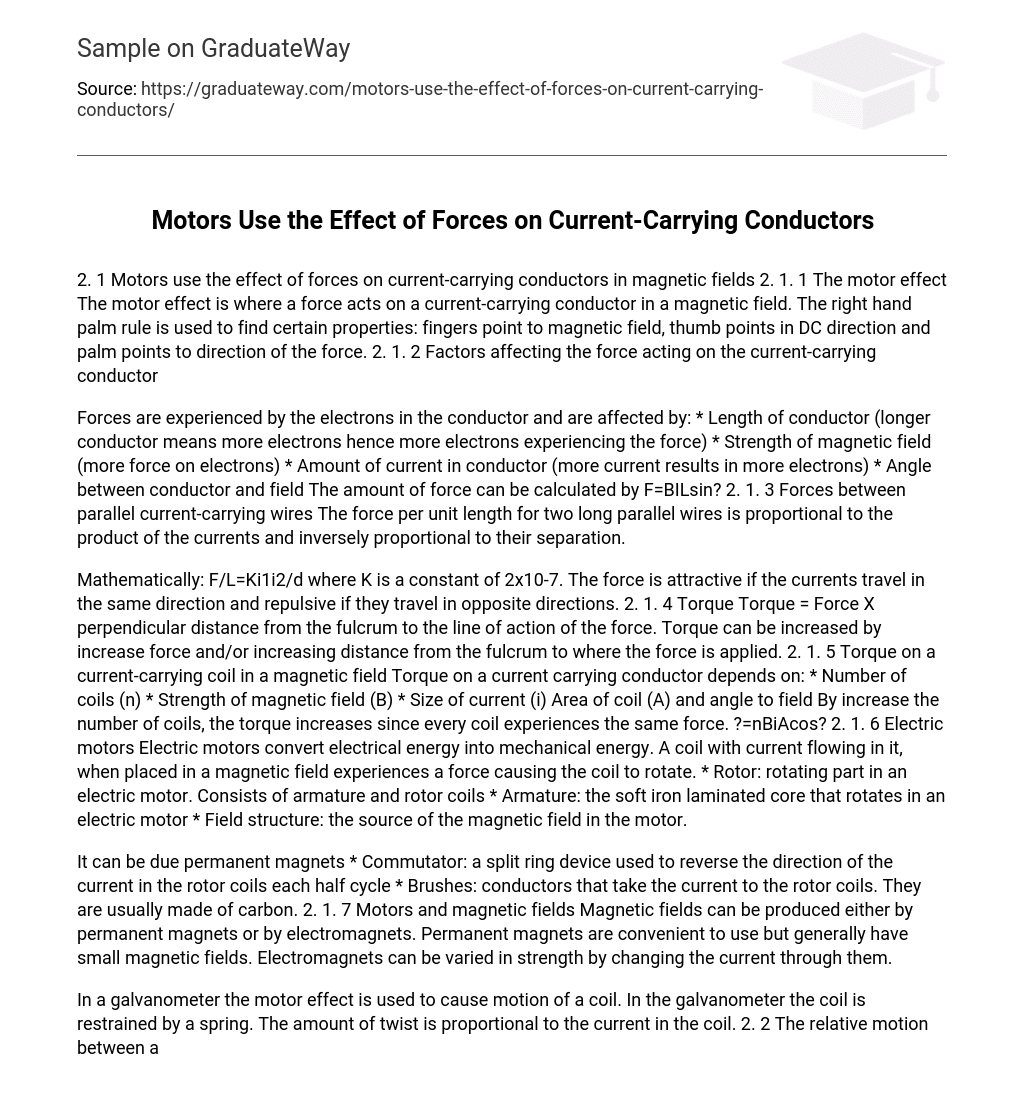2. 1 Motors use the effect of forces on current-carrying conductors in magnetic fields 2. 1. 1 The motor effect The motor effect is where a force acts on a current-carrying conductor in a magnetic field. The right hand palm rule is used to find certain properties: fingers point to magnetic field, thumb points in DC direction and palm points to direction of the force. 2. 1. 2 Factors affecting the force acting on the current-carrying conductor
Forces are experienced by the electrons in the conductor and are affected by: * Length of conductor (longer conductor means more electrons hence more electrons experiencing the force) * Strength of magnetic field (more force on electrons) * Amount of current in conductor (more current results in more electrons) * Angle between conductor and field The amount of force can be calculated by F=BILsin? 2. 1. 3 Forces between parallel current-carrying wires The force per unit length for two long parallel wires is proportional to the product of the currents and inversely proportional to their separation.
Mathematically: F/L=Ki1i2/d where K is a constant of 2×10-7. The force is attractive if the currents travel in the same direction and repulsive if they travel in opposite directions. 2. 1. 4 Torque Torque = Force X perpendicular distance from the fulcrum to the line of action of the force. Torque can be increased by increase force and/or increasing distance from the fulcrum to where the force is applied. 2. 1. 5 Torque on a current-carrying coil in a magnetic field Torque on a current carrying conductor depends on: * Number of coils (n) * Strength of magnetic field (B) * Size of current (i) Area of coil (A) and angle to field By increase the number of coils, the torque increases since every coil experiences the same force. ?=nBiAcos? 2. 1. 6 Electric motors Electric motors convert electrical energy into mechanical energy. A coil with current flowing in it, when placed in a magnetic field experiences a force causing the coil to rotate. * Rotor: rotating part in an electric motor. Consists of armature and rotor coils * Armature: the soft iron laminated core that rotates in an electric motor * Field structure: the source of the magnetic field in the motor.
It can be due permanent magnets * Commutator: a split ring device used to reverse the direction of the current in the rotor coils each half cycle * Brushes: conductors that take the current to the rotor coils. They are usually made of carbon. 2. 1. 7 Motors and magnetic fields Magnetic fields can be produced either by permanent magnets or by electromagnets. Permanent magnets are convenient to use but generally have small magnetic fields. Electromagnets can be varied in strength by changing the current through them.
In a galvanometer the motor effect is used to cause motion of a coil. In the galvanometer the coil is restrained by a spring. The amount of twist is proportional to the current in the coil. 2. 2 The relative motion between a conductor and a magnetic field is used to generate an electrical voltage First hand investigation: Current generation Connect a coil of many turns to a zero centered galvanometer. Move a small magnet in and out of the coil and we can observe a small current is produced when the magnet is moved but no current when there was no movement.
By varying the speed (relative motion) of the movement and strength of magnet, the galvanometer flickered more therefore more current produced. Distance also affects this. 2. 2. 1 Faraday and electromagnetic induction Electromagnetic induction is where an emf is produced when a conductor “cuts” magnetic lines of force. ie there is a change of magnetic flux through a circuit. Faraday’s experiment: Connect a coil of many turns to a zero centered galvanometer. Move a small magnet in and out of the coil and we can observe a small current is produced when the magnet is moved but no current when there was no movement.
By varying the speed (relative motion) of the movement and strength of magnet, the galvanometer flickered more therefore more current produced. Distance also affects this. 2. 2. 2 Magnetic field strength and magnetic flux density Magnetic flux density (B) is a measure of the number of lines of force per unit area. It is also equivalent to the strength of the magnetic field and is measured in Weber (Wb) 2. 2. 3 Magnetic flux Magnetic flux (? ) is a measure of the number of lines of force emerging through an area. It is the product of magnetic flux density and area : ? BA measured in Webers (Wb) 2. 2. 4 Size of the induced emf The induced emf is proportional to the rate of change of magnetic flux through the circuit. 2. 2. 5 Len’s Law Len’s law: the direction of the induced emf is such that it opposes the change that produced it. Len’s law is a consequence of the law of conservation of energy because if the induced emf aided the motion, then the conductor would accelerate causing a greater emf, which would cause further acceleration, etc … an infinite amount of energy would be created. . 2. 6 Len’s Law and back emf 2. 2. 7 Back emf in electric motors 2. 2. 8 Eddy Currents Eddy currents are circular currents induced in bulk conductors placed in a changing magnetic field. Eddy currents are produced by electromagnetic induction. Changing flux induces currents that flow in a circle as this provides minimum resistance. The faster the conductor ‘cuts magnetic flux’ the greater the force of resistance. As the object slows the force is lessened so the braking is smooth and not jerky.





